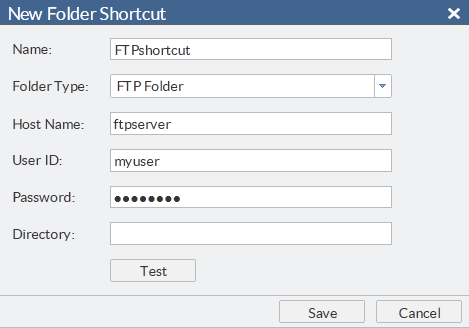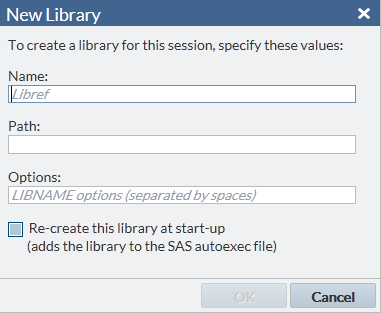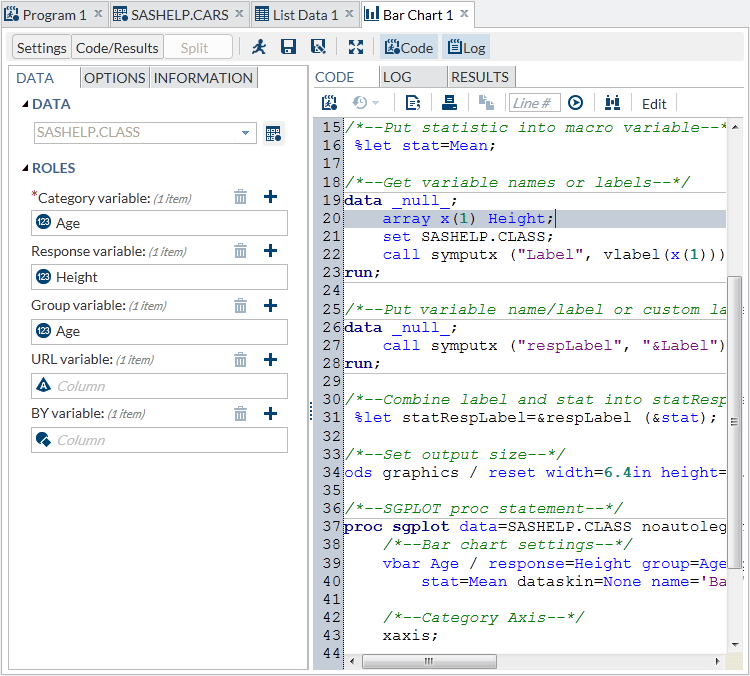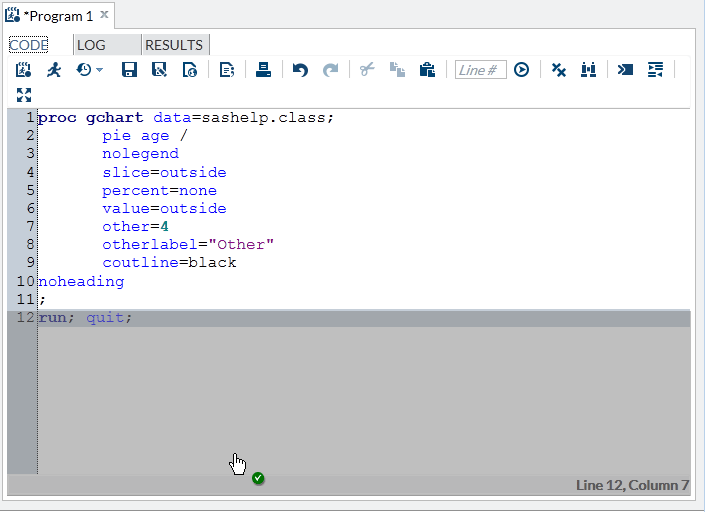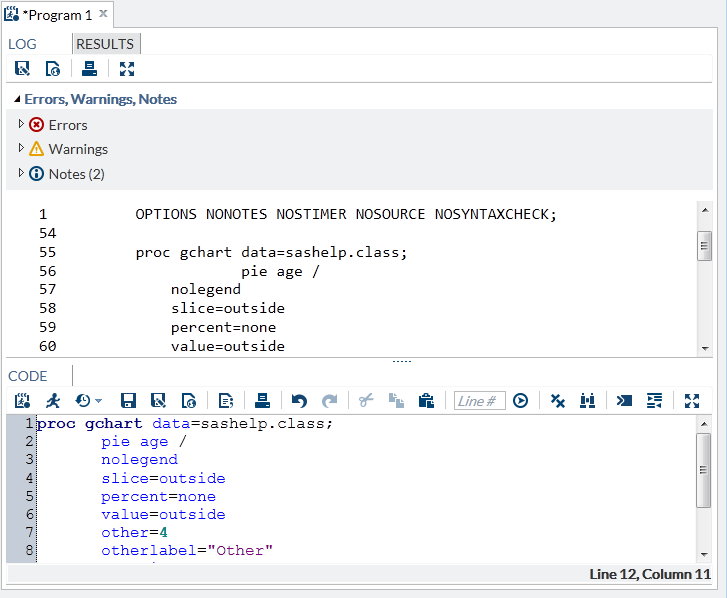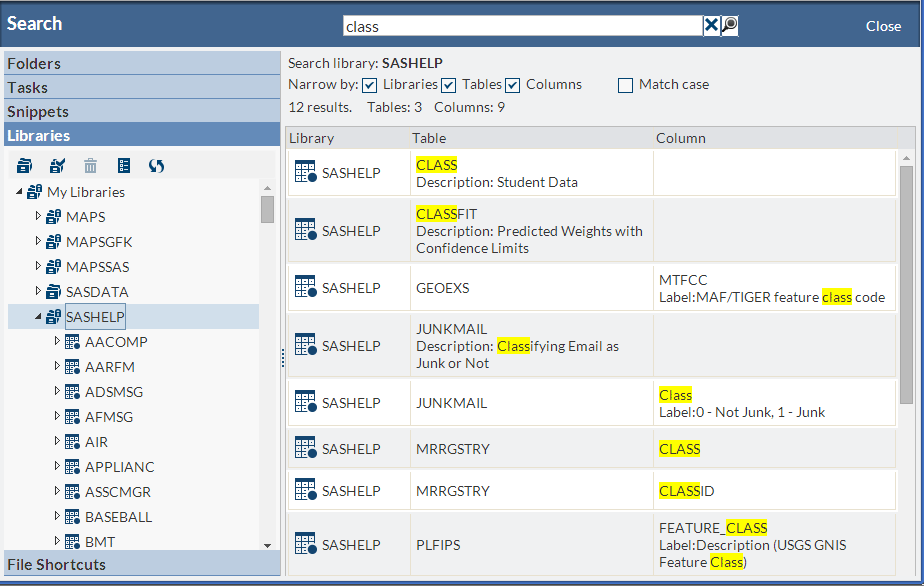Using SAS Studio
About Using SAS Studio
When you sign on to
SAS Studio, the main SAS Studio window appears with a blank program
window so that you can start programming immediately. You also have
access to all five
sections of the navigation pane.
Note: To sign out of SAS Studio,
click the Sign Out button on the toolbar.
Do not use the Back button on your web browser.
The main window of SAS
Studio consists of a navigation pane on the left and a work area on
the right. The navigation pane provides access to your folder shortcuts
and folders, your tasks and snippets, the libraries that you have
access to, and your file shortcuts. The Folders section is displayed
by default.
Using the Navigation Pane
Working with Folders
The Folders section
of the navigation pane enables you to access files and folders from
the following locations:
Note: SAS Studio supports only
FTP servers that use a UNIX style directory listing. Filenames in
Asian languages are not supported on the FTP servers.
The type of SAS Studio
deployment you are using determines the folders and files you can
access from the Folders section and the locations to which you can
assign libraries.
You can open files that
are saved on the SAS server or the FTP server, such as SAS program
files or program package files. You can also open SAS tables that
are saved on the SAS server.
You can use the Folders
section to create folders and folder shortcuts, download and upload
files, and create a new SAS program. From the folders tree, you can
expand and collapse folders and open items in folders by double-clicking
them or dragging them to the work area.
Note: Files and folders that are
located on an FTP server and are accessible by using an FTP shortcut
cannot contain any of the following characters in their names:
{ } [ ] , : ; “ ‘ / \ | + < > ? @ # $ % ^ & ( ) + !SAS Studio cannot access, move, rename, or delete files
and folders on an FTP server whose names contain invalid characters.-
If you are creating a shortcut to a SAS server folder, enter the physical path for the directory in the Directory box.If you are creating a shortcut to an FTP folder, enter the network address of the FTP host in the Host Name box as well as your user name and password. By default, the directory is the home directory of the FTP user. You can use the Directory box to specify another directory that is relative to the home directory. For example, if the home directory of the FTP user is
c:\homedir, and you specifydatain the Directory box, then the root directory of the shortcut isc:\homedir\dataon the FTP server. You can validate your connection to the FTP server by clicking Test.
To create a new folder,
select the folder in the Folders section in which you want to create
the new folder. Click  and select Folder. The
New Folder window opens. Enter the name of the new folder. The new
folder is added to the list of folders.
and select Folder. The
New Folder window opens. Enter the name of the new folder. The new
folder is added to the list of folders.
 and select Folder. The
New Folder window opens. Enter the name of the new folder. The new
folder is added to the list of folders.
and select Folder. The
New Folder window opens. Enter the name of the new folder. The new
folder is added to the list of folders.
Working with Tasks
The Tasks section of
the navigation pane enables you to access tasks in SAS Studio. Tasks
are based on SAS procedures and generate SAS code and formatted results
for you. SAS Studio is shipped with several predefined tasks that
you can run. You can also edit a copy of these predefined tasks, and
you can create your own new tasks.
To create a new task,
click  . SAS Studio creates a template in the work area that
you can use to create custom tasks for your site. Custom tasks can
be accessed from the My Tasks folder. For more information,
see Understanding Tasks in SAS Studio.
. SAS Studio creates a template in the work area that
you can use to create custom tasks for your site. Custom tasks can
be accessed from the My Tasks folder. For more information,
see Understanding Tasks in SAS Studio.
 . SAS Studio creates a template in the work area that
you can use to create custom tasks for your site. Custom tasks can
be accessed from the My Tasks folder. For more information,
see Understanding Tasks in SAS Studio.
. SAS Studio creates a template in the work area that
you can use to create custom tasks for your site. Custom tasks can
be accessed from the My Tasks folder. For more information,
see Understanding Tasks in SAS Studio.To edit a task that
you have created, select the task from the My Tasks folder and click  . The XML code that is used to create the task is
opened in the work area. If you want to edit a predefined task, you
must first right-click the task and select Add to My Tasks. For more information,
see Edit a Predefined Task.
. The XML code that is used to create the task is
opened in the work area. If you want to edit a predefined task, you
must first right-click the task and select Add to My Tasks. For more information,
see Edit a Predefined Task.
 . The XML code that is used to create the task is
opened in the work area. If you want to edit a predefined task, you
must first right-click the task and select Add to My Tasks. For more information,
see Edit a Predefined Task.
. The XML code that is used to create the task is
opened in the work area. If you want to edit a predefined task, you
must first right-click the task and select Add to My Tasks. For more information,
see Edit a Predefined Task.Working with Snippets
The Snippets section
of the navigation pane enables you to access your code snippets. Code snippets are samples of
commonly used SAS code that you can insert into your SAS program.
SAS Studio is shipped with several predefined code snippets that you
can use. You can also edit a copy of these snippets and create your
own custom snippets. Your custom snippets can be accessed from the
My Snippets folder. For more information, see Working with Programs.
Working with Libraries
The Libraries section
of the navigation pane enables you to access your SAS libraries. SAS
tables are stored in SAS libraries. From the Libraries section, you
can open SAS tables and add them to your programs. You can use the
Libraries section to expand a table and view the columns in that table.
The icon in front of the column name indicates the type.
You can drag tables
and columns from the Libraries section to a program, and SAS Studio
adds code for the dragged items to your program. For more information,
see Opening and Creating Programs.
Using File Shortcuts
File shortcuts enable
you to quickly access files that you specify. You can create a file
shortcut to a file on your SAS server, via a URL, or on your FTP server.
Note: You can create a file shortcut
to a file on an FTP server only if you have created a folder shortcut
to an FTP folder.
Using the Work Area
About Using the Work Area
The work area is the
main portion of the SAS Studio application for accessing programs
and tasks and for viewing data. The work area is always displayed
and cannot be minimized. When you open a program, task, or table,
the windows open as new tabs in the work area. The code, log, and
results that are associated with programs and tasks are grouped together
under the main tab for the program or task.
Customizing the View of the Program Tab
Searching in SAS Studio
You can use the Search
feature to search all of the sections of the navigation pane. The
types of items that you can search for depend on what is selected
in the navigation pane. For example, if a folder or folder shortcut
in the Folders section is selected, you can search for folders and
files, and you can choose whether to include subfolders in the search.
If a task category in the Tasks section is selected, you can search
for task names, associated SAS procedures, and task descriptions.
To access the Search
feature, click  . The search box opens so that you can enter the text
that you want to search for.
. The search box opens so that you can enter the text
that you want to search for.
 . The search box opens so that you can enter the text
that you want to search for.
. The search box opens so that you can enter the text
that you want to search for.
You can limit the scope
of your search by selecting or clearing any of the Narrow
by options. These options vary depending on what is selected
in the navigation pane. By default, the search is case sensitive.
To search for both uppercase and lowercase text, clear the Match
case check box.
The following example
shows a search for “class” in the Sashelp library. The
search includes all tables and columns in the Sashelp library, and
it is not case sensitive.
Setting General Preferences
|
opens new programs with
the interactive mode on. This option is available only if you are
running the first maintenance release for SAS 9.4. For more information,
see Working in Interactive Mode.
|
|
Editing the Autoexec File
The autoexec.sas file
includes SAS statements that run each time you start SAS Studio and
connect to your SAS server. For example, you can use the autoexec.sas
file to assign libraries that you want to be available every time
you use SAS Studio in both interactive and noninteractive modes.
Note: If you create a new library
by using the New Library window, you can
select the Re-create this library at start-up option
to automatically add the LIBNAME statement to the autoexec.sas file.
For more information,
see Working with Libraries.
Changing Your SAS Workspace Server
If you have access to
more than one SAS workspace server, you can change the server that
SAS Studio connects to. To change the server, click  and select Change SAS Workspace Server.
Select the server that you want to use. When you change servers, any
libraries and file shortcuts that you created are deleted. For more
information, see SAS Studio 3.2: Administrator's Guide.
and select Change SAS Workspace Server.
Select the server that you want to use. When you change servers, any
libraries and file shortcuts that you created are deleted. For more
information, see SAS Studio 3.2: Administrator's Guide.
 and select Change SAS Workspace Server.
Select the server that you want to use. When you change servers, any
libraries and file shortcuts that you created are deleted. For more
information, see SAS Studio 3.2: Administrator's Guide.
and select Change SAS Workspace Server.
Select the server that you want to use. When you change servers, any
libraries and file shortcuts that you created are deleted. For more
information, see SAS Studio 3.2: Administrator's Guide.
Copyright © SAS Institute Inc. All rights reserved.

